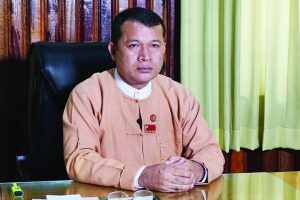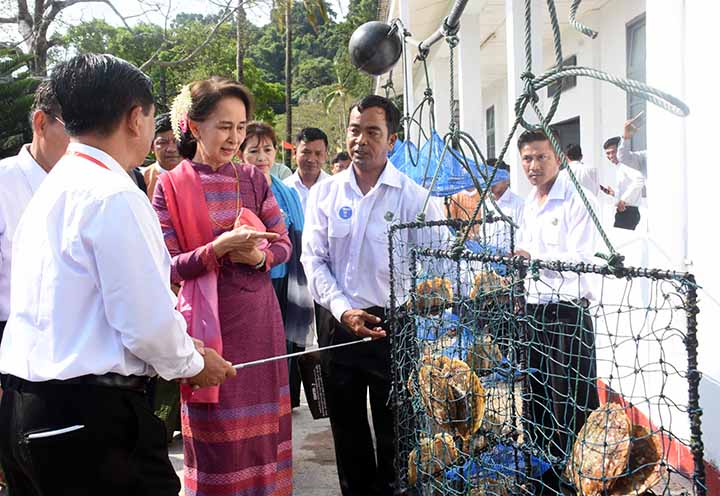From the 2016-2017 FY to 2018-2019 FY, the regional government has executed 351 border developmental projects using K36,990 million from the regional government funds
Taninthayi Region Chief Minister U Myint Maung.
By Nandar Win
Photo: Aye Than
With stunning beaches offering captivating sunsets that attract tourists from home and abroad, Maungmagan beach is full of traditions and customs at the southernmost tip of Myanmar in Taninthayi Region.
The hotels and tourism sector in the region have been called the smokeless factory. There are 30 hotels and 10 guesthouses in the region and 94 tour companies contributing to the development of tourism.
A Travel and Investment Fair was held in Kawthoung from 24 to 25 March last year and highlighted the archipelago routes as the main attraction.
Each of the districts in Taninthayi have their own share of interesting travel destinations. In Dawei District, there are the Shin Koe Shin pagodas, nine historic pagodas sharing the word ‘Shin’ in their names: Shin Pin Kayu, Shin Tauk Htein, Shin Taung Pone, Shin Za Lun, Shin Monti, Shin Ded We, Shin Ote Aou, Kaleinaung Shin Sandaw, and Myat Shin Maw.
As for beaches, there are Maungmagan beach, Myin Kwar Aou beach, Poe Poe Kyauk beach and Sam Hlam beach. The district has the Maungmagan hot springs, traditional Dawei pasoes, longyi weaving businesses, and Dawei pottery.
Myeik District has the Lay Gyun Si Mee Thein Daw Gyi Pagoda, Athu Layan Thi (Pa Htet Taung) Shwe Tar Lyaung reclining Buddha, and island travel routes.
Kawthoung District has the Pyi Taung Aye Pagoda, Ma Li Wam waterfall, 555 hill viewpoint, Bayinnaung island and Bayinnaung cape, Kyun Philar, Bo Ywe, Nga Mahn island, Nga Khin Nyo Gyi island, Nyaung Oo Phi island, Island No. 115, Ka Yin Kwa island, Barlar island (a) Than Yote island, Poe Ni island (a) Bo Yar Nyunt island, Bo Nat Kyaw island, Hlaing Gu island, Nga Htwe Yu island and many more along its extensive archipelago.
Taninthayi is made up of Dawei, Myeik and Kawthoung districts with 10 townships. The regional cabinet began working on regional development on 1 April 2016.
In doing so, they adhere to the policies set by the Union Government on national reconciliation, national stability, establishing a democratic federal Union, rule of law, and raising the living standards of the people.

Objectives
The region’s government returns land to local residents from companies unable to utilize them, developing regional tourism, exporting fishery products abroad, ensuring full security and protection by the rule of law to local people, and making the electricity bill as affordable as possible.
Tasks
The regional cabinet supports the movement for sustainable peace by solving political issues with political methods and organizing political dialogue for every stakeholder to be involved. They advocate for finding peaceful solutions to reforms on politics, economy, society and security.
They cooperate on the emergence of Constitutional law based on democracy and federalism, entitled benefits and opportunities on each ethnic race and gatherings, managing and distributing land and natural resources.
Three pillars of government
Over the course of three years since assuming office, the regional legislature enacted 14 new laws within the first to eleventh regular meeting of the Second Taninthayi Region Hluttaw and reatified 2 bylaws on exisiting laws.
The executive pillar carries out its duties preofessionaly in line with Section 31 (b) of The Region or State Government Law. We also have a high court, 3 district courts, and 10 township courts who perform the duties of the judicial pillar in upholding a free and fair judicial system and adminstereing impartial judgement.
Regional development
From the 2016-2017 FY to 2018-2019 FY, the regional government has executed 351 border developmental projects using K36,990 million from the regional government funds and 179 border developmental projects using K10,808 million from the Union Government fund.
We’ve planted 49,847,097 baskets of monsoon crops on 491,791 acres in the three-year period, 1,232,719 baskets of summer crops on 29,303 acres, and 25,589 acres of winter crops.
Over the course of three years, we have produced 244,745,005 pounds of rubber on 1,041,665 acres, and 1,092,356 tons of edible oil from 422,483 plantation acres.
The regional government has issued 22,054 licenses for inshore fishing and 4,289 licenses for offshore fishing. We’ve also issued work permits for 144,207 fishermen.
Taninthayi Region exported over 6.5 million tons of fish and prawn from the farms from the 2016-2017 fiscal year to February of the current 2018-2019 Fiscal year, earning over US$ 41 million.
The fishery products export from the last fiscal year to February, 2019 reached over 780,125 tons of fishery products worth of over US$ 744 million and over K6.9 billion.

Electricity Production Sector
With increasing in power production, the region has seen an increasing in number of households which get access to electrification.
In three years starting from April, 2016 to January, 2019, a total of 283,099 households get access to electrification.
Effirts for development of SME Sector
Taninthayi Region Government has encouragaged the private small and medium industries by issuing licenses and providing loans to them.
In the three-year period, over 600 private industries were registed in the region.

Improving infrastructure
The Taninthayi Region Government spent over K 5.7 billion on building 15 retaining walls in three years.
The government has improved and upgraded the transportation infrasrcutures including over 630 miles long Union Highway passing through the region, roads with over 440 miles in distance, 50 ft and under 50 ft long 959 bridges, over 50 ft long 24 bridges and 2371 conduit pipes.
Mining Sector
Taninthayi Region has set its target of extracting about 834.816 matric tons of ore in the 2018-2019 fiscal year, and so far, 295.033 tons have been extracted.
Pearl and Oyster production
Regarding the production of pearls and oyster from October to February of the 2018-2019 fiscal year, the region sets its target of producing 387,000 momi of pears and 142 matric tons of oyster. So far, 336,955 momi of pearls and 98 matric tons of oysters have been produced.
Tax and trade
Taninthayi Region earned over K147 billion, Thai baht over 100 million and US$5.956 million in three years from the 2016-2017 fiscal year to 2018-2019 fiscal year.
In the same period, the region’ s trade volume through the border reached over US$1.3 million.
The region’s GDP reached over K5.4 million in the past three years. The par capital income of the region is targeted to reach over K2.9 million.
Efforts for increasing school enrolment rate in Taninthayi Region
The regional government carries out school enrolment week from 25 to 30 May every year since the 2016-2017 fiscal year. Over K1.4 billion contributed by the State and donars were spent on stationery and school uniforms for the students and furniture for the schools in the past three years.
Meanwhile, with the permission of the Ministry of Education, 279 graduates were appointede as the primary school teachers in the 2017-2018 fiscal year.
Out of 20,237 students who took for the 2018 matriculation examination, 6174 passe it, reaching 30.51 passing rate.
Health care services
To promote the quality of basic health care services in Taninthayi Region, the regional government arranged eight trainings in 2016, 14 in 2017 and 19 in 2018, producing 182 nurses from the Dawei Nursing Institute and 201 midwives from the Myeik Mid-wifery Institute.
Public Welfare Services
Taninthayi Region Government conducted 56 vocational trainings in three years and over 1300 trainees received the skills.
Plans are underway to establish a training school for youths from the border areas and the school is under construction starting from the 2018-2019 fiscal year.
Agricultural loans for farmers
In three years, Taninthayi Region Government disbursed over K51 billion for growing paddy in monsoon seasons and over K403.5 million for growing rice in irrigated fields and other crops. Meanwhile, the government lent over K1.4 billion to farmers to buy agro machinery at installments and over K67 million in short-term installments.
Relief efforts and disaster Preparedness in Taninthayi Region
Taninthayi Region Government provided over K151 million to victims of natural disasters from in three years. Recently, the government provided K234.128 million to the people for their houses were destroyed by strongwinds in June and July.
Taninthayi Regional Development Plan
As part of efforts for drafting the Taninthayi Regional Development Plan, the regional government has been working togher with the representatives of the Japanese International Cooperation Agency.
To entrepreneurs from Thailand
The two sides also held talks over the Development Planning in Tanintharyi Region and Dawei Sepcial Economic Zone.
Ralaxing rules and regulations to encourage industries
Taninthayi Region Industry Small and Medium Enteprises Development Department has relazed some rules for lending loans to SMEs and has lent under K10 million to SMEs with the recommendation of the head of the region’s SME Developmemnt Department.
Peace Process
Tanintha Yi Region Government has arranged a meeting for a Yangon-based civil society organization for development of ethnic people and Myeik-based civil society organization to hold talks on peac in Myeik in October.
Besides, the regional government has made arrangement for budget allocation in the 2019-2020 fiscal year for resettlement of people displaced by armed conflicts in the region.
Fruitful results of efforts of Regional Government
In three years, the regional government installed 48 generators with a combined capacity of 30.83 MW in areas which can not get access to the national grid.
In the education sector, the regional government has upgraded a total 374 schools in the region.
Another significant achievement is that Taninthayi Region Hluttaw approved the town plan Pulaw Township and Maungmataw in Launglon Township drafted by the Taninthayi Region Government.
Conservation of the region’s tangible culture
The regional government designated the old city of Taninthayi as the cultural zone.
Besides, in the 2018-2019 fiscal year, the regional government submitted the several regional cultural festivals to the the UNESCO to be included in the cultural heritage list. The cultural heritage of the Taninthayi Region has attracted the local and foreign visitors. For the all round development of the Taninthayi Region including its tourism sector, the Taninthayi Region Government is making strenuous efforts following the polices and guidelines laid down the Union Government.
(Translated by Pen Dali)



